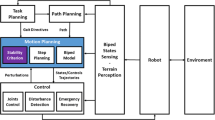Abstract
Dynamical bipedal walking subject to precise footstep placements is crucial for navigating real world terrain with discrete footholds such as stepping stones, especially as the spacing between the stone locations significantly vary with each step. Here, we present a novel methodology that combines a gait library approach along with control barrier functions to enforce strict constraints on footstep placement. We numerically validate our proposed method on a planar dynamical walking model of MARLO, an underactuated bipedal robot. We show successful single-step transitions from a periodic walking gait with a step length of 10 (cm) to a stepping stone with a 100 (cm) separation (10x step length change), while simultaneously enforcing motor torque saturation and ground contact force constraints. The efficacy of our method is further demonstrated through dynamic walking over a randomly generated set of stepping stones requiring single-step step length changes in the range of [10:100] (cm) with a foot placement precision of 2 (cm).
Access this chapter
Tax calculation will be finalised at checkout
Purchases are for personal use only
Preview
Unable to display preview. Download preview PDF.
Similar content being viewed by others
References
“The W-Prize on stepping stones,” http://www.wprize.org/SteppingStones.html.
A. D. Ames, J. Grizzle, and P. Tabuada, “Control barrier function based quadratic programs with application to adaptive cruise control,” in IEEE Conference on Decision and Control, 2014, pp. 6271-6278.
A. D. Ames, K. Galloway, J. W. Grizzle, and K. Sreenath, “Rapidly Exponentially Stabilizing Control Lyapunov Functions and Hybrid Zero Dynamics,” IEEE Trans. Automatic Control, vol. 59, no. 4, pp. 876-891, 2014.
J. Chestnutt, J. Kuffner, K. Nishiwaki, and S. Kagami, “Planning biped navigation strategies in complex environments,” in IEEE International Conference on Humanoid Robotics, 2003, pp. 117-123.
J. Chestnutt, M. Lau, G. Cheung, J. Kuffner, J. Hodgins, and T. Kanade, “Footstep planning for the honda asimo humanoid,” IEEE International Conference on Robotics and Automation., pp. 629 - 634, 2005.
X. Da, O. Harib, R. Hartley, B. Griffin, and J. Grizzle, “From 2d design of underactuated bipedal gaits to 3d implementation: Walking with speed tracking,” IEEE Access, vol. PP, no. 99, pp. 1-1, 2016.
R. Deits and R. Tedrake, “Footstep planning on uneven terrain with mixed-integer convex optimization.” IEEE/RAS International Conference on Humanoid Robots, pp. 279-286, 2014.
R. L. H. Deits, “Convex segmentation and mixed-integer footstep planning for a walking robot,” Master’s thesis, Massachusetts Institute of Technology, 2014.
R. Desai and H. Geyer, “Robust swing leg placement under large disturbances,” IEEE International Conference on Robotics and Biomimetics, pp. 265-270, 2012.
K. Galloway, K. Sreenath, A. D. Ames, and J. W. Grizzle, “Torque saturation in bipedal robotic walking through control lyapunov function based quadratic programs,” IEEE Access, vol. PP, no. 99, p. 1, April 2015.
A. Hereid, C. M. Hubicki, E. A. Cousineau, J. W. Hurst, and A. D. Ames, “Hybrid zero dynamics based multiple shooting optimization with applications to robotic walking,” in IEEE International Conference on Robotics and Automation, 2015, pp. 5734-5740.
M. S. Jones, “Optimal control of an underactuated bipedal robot,” Master’s thesis, Oregon State University, ScholarsArchive@OSU, 2014.
S. Kajita, F. Kanehiro, K. Kaneko, K. Fujiwara, K. Harada, K. Yokoi, and H. Hirukawa, “Biped walking pattern generation by using preview control of zeromoment point,” IEEE International Conference on Robotics and Automation, vol. 2, pp. 1620 - 1626, 2003.
J. J. Kuffner, K. Nishiwaki, S. Kagami, M. Inaba, and H. Inoue, “Footstep planning among obstacles for biped robots,” the IEEE/RSJ International Conference on Intelligent Robots and Systems,, vol. 1, pp. 500 - 505, 2001.
P. Michel, J. Chestnutt, J. Kuffer, and T. Kanade, “Vision-guided humanoid footstep planning for dynamic environments,” in Humanoids, 2005, pp. 13-18.
Q. Nguyen and K. Sreenath, “L1 adaptive control for bipedal robots withcontrol lyapunov function based quadratic programs,” in American Control Conference, 2015, pp. 862-867.
Q. Nguyen and K. Sreenath, “Safety-critical control for dynamical bipedal walking with precise footstep placement,” in The IFAC Conference on Analysis and Design of Hybrid Systems, 2015, pp. 147-154.
Q. Nguyen and K. Sreenath, “Exponential control barrier functions for enforcing high relative-degree safety-critical constraints,” in American Control Conference, 2016, pp. 322-328.
Q. Nguyen and K. Sreenath, “Optimal robust control for constrained nonlinear hybrid systems with application to bipedal locomotion,” in American Control Conference, 2016.
Q. Nguyen and K. Sreenath, “3d dynamic walking on stepping stones with control barrier functions,” in 2016 IEEE 55th Conference on Decision and Control, To Appear, 2016.
A. Ramezani, J. W. Hurst, K. Akbari Hamed, and J. W. Grizzle, “Performance Analysis and Feedback Control of ATRIAS, A Three-Dimensional Bipedal Robot,” Journal of Dynamic Systems, Measurement, and Control, vol. 136, no. 2, 2014.
M. Rutschmann, B. Satzinger, M. Byl, and K. Byl, “Nonlinear model predictive control for rough-terrain robot hopping,” IEEE/RSJ International Conference on Intelligent Robots and Systems, pp. 1859-1864, 2012.
E. R. Westervelt, J. W. Grizzle, C. Chevallereau, J. Choi, and B. Morris, Feedback Control of Dynamic Bipedal Robot Locomotion, ser. Control and Automation. Boca Raton, FL: CRC, June 2007.
T. Yang, E. Westervelt, A. Serrani, and J. P. Schmiedeler, “A framework for the control of stable aperiodic walking in underactuated planar bipeds,” Autonomous Robots, vol. 27, no. 3, pp. 277-290, 2009.
Author information
Authors and Affiliations
Corresponding author
Editor information
Editors and Affiliations
Rights and permissions
Copyright information
© 2020 Springer Nature Switzerland AG
About this chapter
Cite this chapter
Nguyen, Q., Da, X., Grizzle, J.W., Sreenath, K. (2020). Dynamic Walking on Stepping Stones with Gait Library and Control Barrier Functions. In: Goldberg, K., Abbeel, P., Bekris, K., Miller, L. (eds) Algorithmic Foundations of Robotics XII. Springer Proceedings in Advanced Robotics, vol 13. Springer, Cham. https://doi.org/10.1007/978-3-030-43089-4_25
Download citation
DOI: https://doi.org/10.1007/978-3-030-43089-4_25
Published:
Publisher Name: Springer, Cham
Print ISBN: 978-3-030-43088-7
Online ISBN: 978-3-030-43089-4
eBook Packages: Intelligent Technologies and RoboticsIntelligent Technologies and Robotics (R0)




